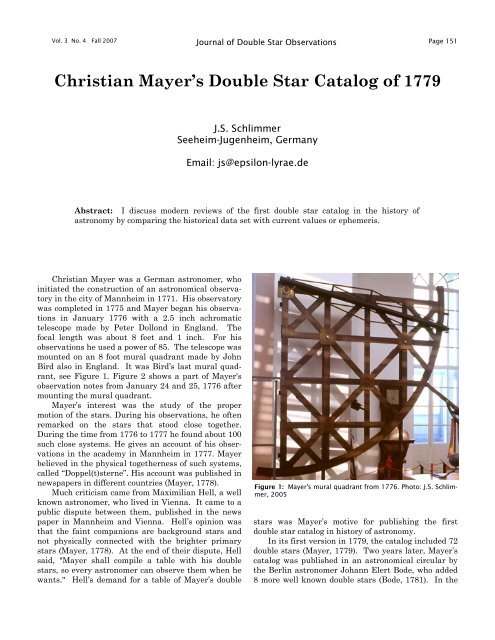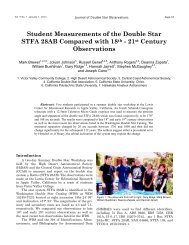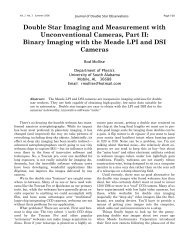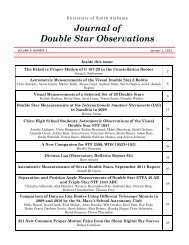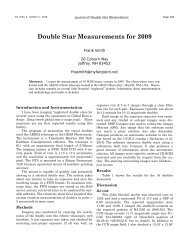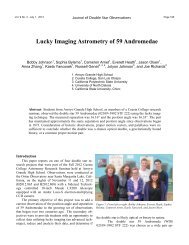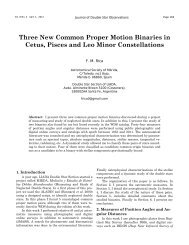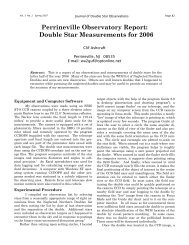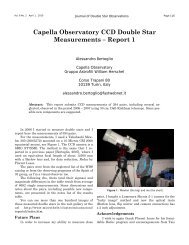Christian Mayer's Double Star Catalog of 1779 - JDSO.org
Christian Mayer's Double Star Catalog of 1779 - JDSO.org
Christian Mayer's Double Star Catalog of 1779 - JDSO.org
Create successful ePaper yourself
Turn your PDF publications into a flip-book with our unique Google optimized e-Paper software.
Vol. 3 No. 4 Fall 2007 Journal <strong>of</strong> <strong>Double</strong> <strong>Star</strong> Observations<br />
Page 151<br />
<strong>Christian</strong> Mayer’s <strong>Double</strong> <strong>Star</strong> <strong>Catalog</strong> <strong>of</strong> <strong>1779</strong><br />
<strong>Christian</strong> Mayer was a German astronomer, who<br />
initiated the construction <strong>of</strong> an astronomical observatory<br />
in the city <strong>of</strong> Mannheim in 1771. His observatory<br />
was completed in 1775 and Mayer began his observations<br />
in January 1776 with a 2.5 inch achromatic<br />
telescope made by Peter Dollond in England. The<br />
focal length was about 8 feet and 1 inch. For his<br />
observations he used a power <strong>of</strong> 85. The telescope was<br />
mounted on an 8 foot mural quadrant made by John<br />
Bird also in England. It was Bird’s last mural quadrant,<br />
see Figure 1. Figure 2 shows a part <strong>of</strong> <strong>Mayer's</strong><br />
observation notes from January 24 and 25, 1776 after<br />
mounting the mural quadrant.<br />
Mayer’s interest was the study <strong>of</strong> the proper<br />
motion <strong>of</strong> the stars. During his observations, he <strong>of</strong>ten<br />
remarked on the stars that stood close together.<br />
During the time from 1776 to 1777 he found about 100<br />
such close systems. He gives an account <strong>of</strong> his observations<br />
in the academy in Mannheim in 1777. Mayer<br />
believed in the physical togetherness <strong>of</strong> such systems,<br />
called “Doppel(t)sterne”. His account was published in<br />
newspapers in different countries (Mayer, 1778).<br />
Much criticism came from Maximilian Hell, a well<br />
known astronomer, who lived in Vienna. It came to a<br />
public dispute between them, published in the news<br />
paper in Mannheim and Vienna. Hell’s opinion was<br />
that the faint companions are background stars and<br />
not physically connected with the brighter primary<br />
stars (Mayer, 1778). At the end <strong>of</strong> their dispute, Hell<br />
said, "Mayer shall compile a table with his double<br />
stars, so every astronomer can observe them when he<br />
wants." Hell’s demand for a table <strong>of</strong> Mayer’s double<br />
J.S. Schlimmer<br />
Seeheim-Jugenheim, Germany<br />
Email: js@epsilon-lyrae.de<br />
Abstract: I discuss modern reviews <strong>of</strong> the first double star catalog in the history <strong>of</strong><br />
astronomy by comparing the historical data set with current values or ephemeris.<br />
Figure 1: <strong>Mayer's</strong> mural quadrant from 1776. Photo: J.S. Schlimmer,<br />
2005<br />
stars was Mayer’s motive for publishing the first<br />
double star catalog in history <strong>of</strong> astronomy.<br />
In its first version in <strong>1779</strong>, the catalog included 72<br />
double stars (Mayer, <strong>1779</strong>). Two years later, Mayer’s<br />
catalog was published in an astronomical circular by<br />
the Berlin astronomer Johann Elert Bode, who added<br />
8 more well known double stars (Bode, 1781). In the
Vol. 3 No. 4 Fall 2007 Journal <strong>of</strong> <strong>Double</strong> <strong>Star</strong> Observations<br />
Page 152<br />
1781 version, the catalog included 80 double stars.<br />
The closest system was 5 epsilon Lyrae with a separation<br />
<strong>of</strong> 2.9 arc seconds. It gives us a good impression <strong>of</strong><br />
the quality <strong>of</strong> Mayer’s telescope. The minimum separation<br />
<strong>of</strong> a perfect 2.5 inch reflector is about 1.7”.<br />
William Herschel heard in <strong>1779</strong> about Mayer’s<br />
work and started his own observations <strong>of</strong> double stars.<br />
His intention was not to study the proper motion, he<br />
wanted to measure parallax (Herschel, 1782). Their<br />
method <strong>of</strong> operation in making their measurements<br />
was very different. With a mural quadrant, differences<br />
in declination were pick up directly, the differences<br />
in right ascension were measured with help <strong>of</strong><br />
an astronomical pendulum clock (Mayer, 1778). With<br />
a declination <strong>of</strong> 0 degree, a star moves 15 arc second<br />
in one time second. In this way measurements were<br />
done in Cartesian coordinates. In opposition to Mayer<br />
<strong>Christian</strong> Mayer’s <strong>Double</strong> <strong>Star</strong> <strong>Catalog</strong> <strong>of</strong> <strong>1779</strong><br />
Figure 2: Mayer’s observation notes from January 24 and 25 , 1776, photo: J. S. Schlimmer 2007<br />
Herschel measured the separation and the position<br />
angle directly in polar coordinates by comparing his<br />
observation with the placement <strong>of</strong> his lamp micrometer.<br />
In 1782 Herschel published his first double star<br />
catalog in the Philosophical Transactions.<br />
In Mayer’s catalog, <strong>of</strong>ten the stars had no name,<br />
but the coordinates for the year <strong>of</strong> his observations<br />
1777 and 1778 are described. Because the precession<br />
<strong>of</strong> the earth's axis, the coordinates are obsolete. For<br />
example, gamma Arietis has moved 12 arc minutes in<br />
right ascension and 1 degree in declination. The first<br />
step <strong>of</strong> my review <strong>of</strong> Mayer’s catalog was to calculate<br />
the current coordinates. With the, new coordinates<br />
many unnamed doubles could be identified.<br />
The second step <strong>of</strong> my review was to transform<br />
Mayer’s Cartesian coordinates into polar coordinates.<br />
Because the way a star moves in time depends on its
Vol. 3 No. 4 Fall 2007 Journal <strong>of</strong> <strong>Double</strong> <strong>Star</strong> Observations<br />
Page 153<br />
declination, the calculations were done by the individual<br />
declinations <strong>of</strong> 1778.<br />
Mayer’s observation results could then be checked<br />
by comparison with current values <strong>of</strong> separation and<br />
angular position. Often there is no movement between<br />
the companions and separation and position<br />
angle are the same as in 1778. However, for some<br />
double star systems there is an orbit. With known<br />
orbital elements the position angle and separation<br />
can be calculated for 1778 and used for comparison. In<br />
some cases <strong>of</strong> components with equal brightness the<br />
position angles disagree by about 180 degrees.<br />
By checking Mayer’s values with data sets <strong>of</strong> The<br />
Washington <strong>Double</strong> <strong>Star</strong> <strong>Catalog</strong>, I <strong>of</strong>ten found entries<br />
for 1777 with equal or similar values cited by<br />
Herschel, Lewis and Strand (Mason, et al. 2007).<br />
In the following table you’ll find my calculations<br />
based on Mayer’s observations <strong>of</strong> 1778 described in<br />
detail in his “Tabula Nova Stellarum Duplicium”<br />
(Mayer, <strong>1779</strong>). Mayer 8, Mayer 10, Mayer 15,<br />
Mayer 32, Mayer 37, Mayer 48, Mayer 51 and Mayer<br />
63 were not included in Mayer’s first catalogue <strong>of</strong><br />
<strong>1779</strong>. The value <strong>of</strong> those stars were in the astronomical<br />
circular <strong>of</strong> Bode in 1781.<br />
In some cases, I couldn’t identify Mayer’s observations.<br />
For Mayer 10, Mayer 16, Mayer 26, Mayer 27,<br />
Mayer 45, Mayer 53, Mayer 63, Mayer 69, Mayer 71,<br />
Mayer 74 and Mayer 78 I give the double stars which<br />
best match Mayer’s transformed coordinates. In other<br />
cases like alpha Arietis or omega Piscis,<br />
the stars are not visual double stars.<br />
Figure 3 represents the relative<br />
error <strong>of</strong> Mayers distance measurements.<br />
In 12 cases the error is under<br />
5%, in 7 cases the error lies between 5<br />
and 10%, and in a further 14 cases the<br />
error lies between 10 and 20%. In some<br />
cases the relative error is explained by<br />
the independent movement <strong>of</strong> the<br />
components e.g. with Mayer 36. In<br />
other cases, for example with Castor<br />
(Mayer 21), incorrect time measurement<br />
<strong>of</strong> the distance in right ascension<br />
significantly affects the results.<br />
With a relative error <strong>of</strong> nearly<br />
300%, Mayers measurements <strong>of</strong> 54<br />
Virginis (Mayer 35) are the worst. Out<br />
<strong>of</strong> 57 measurements between 1777 and<br />
2006 it follows that neither distance<br />
nor position angle has changed.<br />
<strong>Christian</strong> Mayer’s <strong>Double</strong> <strong>Star</strong> <strong>Catalog</strong> <strong>of</strong> <strong>1779</strong><br />
References<br />
Gründliche Vertheidigung neuer Beobachtungen von<br />
Fixsterntrabanten, welche zu Mannheim auf der<br />
kurfürstlichen Sternwarte entdeckt worden sind,[<br />
Defense <strong>of</strong> new Observations <strong>of</strong> Fixed <strong>Star</strong> Satellites],<br />
<strong>Christian</strong> Mayer, Mannheim 1778<br />
De novis in coelo sidereo phaenomenis in miris stellarum<br />
fixarum comitibus, <strong>Christian</strong> Mayer, Mannheim<br />
<strong>1779</strong><br />
Verzeichniss aller bisher entdeckten Doppelsterne<br />
[Directory <strong>of</strong> all hitherto discovered doubled<br />
stars], Berliner Astronomisches Jahrbuch für<br />
1784, <strong>Christian</strong> Mayer, published by Johann Elert<br />
Bode, 1781<br />
<strong>Catalog</strong> <strong>of</strong> <strong>Double</strong> <strong>Star</strong>s, William Herschel, Philosophical<br />
Transactions <strong>of</strong> the Royal Society <strong>of</strong> London,<br />
1782 Vol. 72<br />
On the Parallax <strong>of</strong> the Fixed <strong>Star</strong>s, William Herschel,<br />
Philosophical Transactions <strong>of</strong> the Royal Society <strong>of</strong><br />
London, 1782 Vol. 72<br />
Description <strong>of</strong> a Lamp-Micrometer, and the Method <strong>of</strong><br />
using it, William Herschel, Philosophical Transac-<br />
(Continued on page 158)<br />
Figure 3: Relative error for Mayers' distance measurements for each double star<br />
system in his catalog.
Vol. 3 No. 4 Fall 2007 Journal <strong>of</strong> <strong>Double</strong> <strong>Star</strong> Observations<br />
Page 154<br />
Mayer’s<br />
Current<br />
WDS Sep. Sep. Sep. pa pa pa mag.<br />
No. Description Description Code Identifier 1778 2007 Diff. 1778 2007 diff WDS note<br />
Mayer 1 Andromeda HIP3617 STFA 1 00464+3057 45.9 47.1 -1.2 238 46 192 7.25,7.43<br />
Mayer 2 Androm. 74 ψ Pisces STF 88AB 01057+2128 32.5 30.3 2.2 154 159 -5 5.27,5.45<br />
Mayer 3 zeta Fische ζ Piscis STF 100AB 01137+0735 24.3 23.3 1.0 67 63 4 5.22,6.15<br />
Mayer 4 bei my Fische BSC 419 STF 122 01269+0332 4.2 5.9 -1.7 180 328 -148 6.65,9.51<br />
Mayer 5 Gamma Widder γ Arietis STF 180AB 01535+1918 12.5 7.6 4.9 193 0 193 4.52,4.58<br />
Mayer 6 Lambda Widder λ Arietis H 5 12AB 01579+2336 38.7 38.2 0.5 46 47 -1 4.80,6.65<br />
<strong>Christian</strong> Mayer’s <strong>Double</strong> <strong>Star</strong> <strong>Catalog</strong> <strong>of</strong> <strong>1779</strong><br />
Mayer 7 Gamma Andromeda γ Andromedae STF 205A-BC 02039+4220 12.2 9.6 2.6 62 63 -1 2.31,5.02<br />
Mayer 8 Alpha Widder α Arietis - - - - - - - - 2.0 1,2<br />
Mayer 9 30 Widder 30 Arietis STFA 5 02370+2439 41.4 39.0 2.4 276 275 1 6.50,7.02<br />
Mayer 10 Wahlfisch BSC 587 HJ 3476AB 02004-0831 22.2 62.6 -40.4 98 200 -102 5.5,9.8 1<br />
Mayer 11 Stier BSC 1065 STF 401 03313+2734 26.7 11.6 15.1 90 270 -180 6.58,6.93<br />
Mayer 12 tau Stier τ 94 Taurus S 455Aa-B 04422+2257 60.3 63.0 -2.7 210 214 -4 4.24,7.02<br />
Mayer 13 Stier BSC 1600 SHJ 49AB 04590+1433 43.6 40.3 3.3 303 305 -2 6.06,7.43<br />
Mayer 14 Orion σ Orionis STF 762AB,C 05387-0236 25.8 13.4 12.4 36 84 -49 3.76,6.56<br />
σ Orionis STF 762AB,E 05387-0236 36.6 41.5 -4.9 55 62 -7 3.76,6.34<br />
Mayer 15 Delta Orion δ Orionis STFA 14Aa-C 05320-0018 50.0 53.3 -3.3 0 1 -1 2.41,6.83 1<br />
05441-0229 15.0 94.8 -79.8 90 316 -226 9.43,9.77<br />
A 291.8A-<br />
BC<br />
TYC 4771-<br />
01005-1<br />
Mayer 16 bei Zeta Orion<br />
Mayer 17 Zwillinge - - - 72.9 - - 310 - - - 2<br />
Or. (11<br />
Mayer 18 Or. (11 Einh.)<br />
STF 919AB 06288-0702 9.6 7.1 2.5 322 133 189 4.62,5.00<br />
Einh.)<br />
Mayer 19 30 Zwillinge HIP 31158 STF 924AB 06323+1747 22.2 19.7 2.5 211 211 0 6.31,6.88<br />
Mayer 20 Zwillinge HIP 31323 S 524AB 06341+2207 47.0 53 -6.0 62 244 -182 7.17,7.41<br />
Mayer 21 Castor α Gemini STF1110AB 07346+3153 9.6 3.6 6.0 293 310 -17 1.93,2.97 3<br />
Mayer 22 Zeta Krebs ζ Cancri STF1196AB-C 08122+1739 7.7 6.1 1.6 180 181 -1 5.05,6.20<br />
STF1223 08268+2656 8.8 5.0 3.8 131 215 .-84 6.16,6.21 11<br />
2 Phi Canceri<br />
Mayer 23 2. Phi Krebs<br />
Table continued on next page.
Vol. 3 No. 4 Fall 2007 Journal <strong>of</strong> <strong>Double</strong> <strong>Star</strong> Observations<br />
Page 155<br />
Mayer’s<br />
Current<br />
WDS Sep. Sep. Sep. pa pa pa mag.<br />
No. Description Description Code Identifier 1778 2007 Diff. 1778 2007 diff WDS note<br />
Mayer 24 Krebs, dunkel 24 Canceri STF1224A-BC 08267+2432 5.4 -5.4 50 -50 6.92,7.53<br />
Mayer 25 iota Krebs ι Canceri STF1268 08467+2846 32.6 30.7 1.9 307 308 -1 4.13,5.99<br />
STT 569Aa-C 09123+1500 6.0 20 -14.0 0 216 -216 6.56,10.4<br />
0<br />
TYC0825-<br />
01529-1<br />
Mayer 26 bei pi Krebs<br />
Mayer 27 bei pi Krebs - - - - - - - - - - 2<br />
Mayer 28 54 Löwe 54 Leonis STF1487 10556+2445 7.2 6.5 0.7 110 112 -2 4.48,6.30<br />
bei tau Löwe Nr.<br />
Mayer 29<br />
83 Leonis STF1540AB 11268+0301 28.9 28.6 0.3 51 150 -99 6.55,7.50<br />
83<br />
Mayer 30 tau Löwe τ Leonis STFA 19AB 11279+0251 39.9 88.9 -49.0 158 181 -23 5.05,7.47<br />
<strong>Christian</strong> Mayer’s <strong>Double</strong> <strong>Star</strong> <strong>Catalog</strong> <strong>of</strong> <strong>1779</strong><br />
Mayer 31 a Wasserschlange BSC4443 H 3 96 11323-2916 13.6 9.4 4.2 137 210 -73 5.64,5.73<br />
Haar der<br />
Mayer 32<br />
BSC4698 STF1633 12207+2703 - 8.9 - - 245 - 7.04,7.13 1<br />
Berenike<br />
Mayer 33 gamma Jungfrau γ Virginis STF1670AB 12417-0127 9.8 5.5 4.3 130 314 -184 3.48,3.53 4<br />
Mayer 34 12 Jagdhunde<br />
α Canis<br />
STF1692 12560+3819 22.4 19.3 3.1 226 229 -3 2.85,5.52<br />
Venatici<br />
Mayer 35 54 Jungfrau 54 Virginis SHJ 151 13134-1850 21.5 5.4 16.1 266 34 232 6.78,7.19<br />
Mayer 36 Jungfrau HIP64638 SHJ 162Aa-B 13149-1122 30.3 107.6 - 77 - - 7.11,8.18 5<br />
STF1744AB 13239+5456 0.0 13.9 -13.9 153 -153 2.23,3.88 1<br />
ζ Ursa<br />
Majoris<br />
Zeta gr. Bären<br />
*)<br />
Mayer 37<br />
Mayer 38 Pi Bootes π 29 Bootes STF1864AB 14407+1625 7.4 5.5 1.9 106 111 -5 4.88,5.79<br />
Mayer 39 Beta Scorpion β Scorpii H 3 7AC 16054-1948 15.4 13.1 2.3 40 24 16 2.59,4.52<br />
Mayer 40 Ny Scorpion ν Scorpii H 5 6Aa-C 16120-1928 42.0 41.2 0.8 336 338 -2 4.35,5.31<br />
Mayer 41 12 im Herkules 36 Hercules STFA 31Aa-B 16406+0413 70.3 69.1 1.2 228 229 1 5.76,6.92<br />
Mayer 42 alpha Ophiuch. α Ophiuchi - - 13.2 - - 180 - - - 2<br />
Mayer 43 alpha Herkules α Hercules STF2140Aa-B 17146+1423 8.7 4.7 4.0 118 105 13 3.48,5.40<br />
Mayer 44 39 Ophiuch. 39 Ophiuchi H 3 25 17180-2417 14.0 10.3 3.7 180 352 -172 5.23,6.64<br />
70 (!)<br />
Mayer 45 71 Herkules<br />
S 687AB 17209+2430 2.4 224.7 -222.3 90 56 34 5.12,9.33<br />
Hercules<br />
Mayer 46 roh Herkules ρ Hercules STF2161Aa-B 17237+3709 7.6 4.1 3.5 291 319 -28 4.50,5.40<br />
Mayer 47 61 Ophiuch. 61 Ophiuchi STF2202AB 17446+0235 19.9 21.3 -1.4 102 93 9 6.13,6.47<br />
Table continued on next page.
Vol. 3 No. 4 Fall 2007 Journal <strong>of</strong> <strong>Double</strong> <strong>Star</strong> Observations<br />
Page 156<br />
Mayer’s<br />
Current<br />
WDS Sep. Sep. Sep. pa pa pa mag.<br />
No. Description Description Code Identifier 1778 2007 Diff. 1778 2007 diff WDS note<br />
Mayer 48 b Schützen β Sagittarius DUN 226 19226-4428 - 28.6 - - 76 - 3.98,7.21 1<br />
Mayer 49 beim Oph. - - - 1.4 - - 90 - - - 2<br />
Mayer 50 Herkul. 95 Her STF2264 18015+2136 8.5 6.5 2.0 260 257 3 4.85,5.20<br />
Mayer 51 rho Ophiuchi ρ Ophiuchi H 2 19AB 16256-2327 7.6 3.1 2.9 90 340 -250 5.07,5.74 1<br />
Mayer 52 Herkules 100 Her STF2280Aa-B 18078+2606 17.5 14.3 3.2 180 183 -3 5.81,5.84<br />
Mayer 53 Schlange HIP89489 STF2296 18157-0321 0.0 3.3 -3.3 90 6 84 7.48,10.22<br />
<strong>Christian</strong> Mayer’s <strong>Double</strong> <strong>Star</strong> <strong>Catalog</strong> <strong>of</strong> <strong>1779</strong><br />
Mayer 54 Schütze BSC6848 SHJ 264AB-C 18187-1837 9.9 17.5 -7.6 51 -51 6.86,7.63<br />
Mayer 55 Ophiuchus 61 Serpentis - - 2.0 - - 0 - - - 2<br />
Mayer 56 zeta Leyer ζ Lyrae STFA 38AD 18448+3736 45.3 43.6 1.7 148 150 -2 4.34,5.62<br />
Mayer 57 epsilon Leyer 4 ε Lyrae STF2382AB 18443+3940 3.8 3.4 0.4 38 31 7 5.15,6.10 6<br />
Mayer 58 5. Leyer 5 ε Lyrae STF2383Cc-D 18443+3940 2.5 2.9 -0.4 180 155 25 5.25,5.38 7<br />
Mayer 59 beta Leyer β Lyrae STF 39AB 18501+3322 48.4 47.4 1.0 151 149 2 3.63,6.69<br />
Mayer 60 theta Schlange θ Serpentis STF2417AB 18562+0412 23.4 23.0 0.4 106 104 2 4.59,4.93<br />
Mayer 61 eta Leyer η Lyrae STF2487AB 19138+3909 23.5 28.6 -5.1 90 81 9 4.38,8.58<br />
Mayer 62 beta Schwan β Lyrae STFA 43Aa-B 19307+2758 33.9 35.3 -1.4 54 54 0 3.19,4.68<br />
Mayer 63 bei gamma Schwan HIP104064 STF2753 21050+3526 7.0 29.9 -22.9 180 336 -156 7.38,10.74 1<br />
Mayer 64 omega Steinbock<br />
ω Capricor-<br />
SHJ 324 20299-1835 25.6 22.6 3.0 242 239 3 5.91,6.68<br />
nus<br />
Mayer 65 Delphin BSC7840 STF2690Aa-BC 20312+1116 15.2 17.8 -2.6 103 255 -152 7.12,7.39<br />
über beta Del-<br />
Mayer 66<br />
HIP101698 STF2703AB 20368+1444 29.5 25.2 4.3 249 290 -41 8.35,8.42<br />
phin<br />
Mayer 67 gamma Delphin γ Delphinus STF2727 20467+1607 17.5 9.1 8.4 278 266 12 4.36,5.03<br />
Mayer 68 beim Füllen ε Equuleus STF2737AB-C 20591+0418 13.8 10.7 3.1 78 67 11 5.30,7.05<br />
Mayer 69 Schwan HIP104064 STF2753 21050+3526 15.3 29.9 -14.6 126 336 -210 7.38,10.74<br />
Mayer 70 Schwan 61 Cygni STF2758AB 21069+3845 15.3 13.8 1.5 51 48 3 5.35,6.10 8<br />
Mayer 71 Schwan HIP104417 S 779 21091+3844 6.0 111.6 -105.6 180 11 169 7.61,9.57<br />
Table continued on next page.
Vol. 3 No. 4 Fall 2007 Journal <strong>of</strong> <strong>Double</strong> <strong>Star</strong> Observations<br />
Page 157<br />
Mayer’s<br />
Current<br />
WDS Sep. Sep. Sep. pa pa pa mag.<br />
No. Description Description Code Identifier 1778 2007 Diff. 1778 2007 diff WDS note<br />
Mayer 72 my Schwan μ Cygni STF2822AB 21441+2845 11.2 6.9 4.3 109 109 0 4.75,6.18 9<br />
Mayer 73 Wassermann HD 208718 STF2848 21580+0556 15.5 10.9 4.6 75 57 18 7.21,7.73<br />
Mayer 74 Zeta Wassermann 74 ψ Pisces STF 88AB 01057+2128 4.6 30.3 -25.7 221 156 65 5.27,5.45<br />
Mayer 75 Wassermann HIP114702 STF2993AB 23141-0855 26.0 24.4 1.6 180 177 3 7.60,8.17<br />
Mayer 76 Wassermann HD 220436 STF3008 23238-0828 - 6.3 - - 151 - 7.21,7.67<br />
<strong>Christian</strong> Mayer’s <strong>Double</strong> <strong>Star</strong> <strong>Catalog</strong> <strong>of</strong> <strong>1779</strong><br />
Mayer 77 Fische HIP116035 STF3019 23307+0515 - 10.4 - - 184 - 7.77,8.37<br />
TYC2772-<br />
Mayer 78 Andromeda<br />
SHJ 358 23543+3154 0.0 36.5 - - 334 - 8.25,10.37<br />
00004-1<br />
Mayer 79 omega Fische ω Piscis - - - - - - - - - 2<br />
Mayer 80 Andromeda BSC9075 STF3050 23595+3343 4.3 3.7 0.6 180 179 1 6.46,6.72 10<br />
Description :<br />
Column 1 : Number from (Bode, 1781)<br />
Column 2 : Mayer’s Description from (Bode, 1781)<br />
Column 3 : Current Description from (H<strong>of</strong>fleit,<br />
1991) and Redshift 5<br />
Column 4 : Code from Washington <strong>Double</strong> <strong>Star</strong><br />
<strong>Catalog</strong><br />
Column 5 : Separation for 1778 from (Mayer,<strong>1779</strong>)<br />
except note 1<br />
Column 6 : Current separation from Washington<br />
<strong>Double</strong> <strong>Star</strong> <strong>Catalog</strong> except note 3,4,6-10,11<br />
Column 7 : Separation differences = Column 5 –<br />
Column 6<br />
Column 8 : Position angle for 1778 from (Mayer,<br />
<strong>1779</strong>), except note 1<br />
Column 9 : Current position angle from Washington<br />
<strong>Double</strong> <strong>Star</strong> <strong>Catalog</strong>, except note 3,4,6-10,11<br />
Column 10: Position angle differences = Column<br />
8 – Column 9<br />
Column 11: Brightness from Washington <strong>Double</strong><br />
<strong>Star</strong> <strong>Catalog</strong><br />
Column 12: Notes<br />
Notes:<br />
1. Published first in Bode’s astronomical yearbook<br />
in 1781<br />
2. No double star<br />
3. Ephemeris for 1778, Doc1985<br />
4. Ephemeris for 1778, Sca2006b<br />
5. The proper motion is 0.37"/year<br />
6. Ephemeris for 1778, Nov.2006e<br />
7. Ephemeris for 1778, Doc1984b<br />
8. Ephemeris for 1778, Kis1997<br />
9. Ephemeris for 1778, Hei1995<br />
10.Ephemeris for 1778, Sta1977b<br />
11.Ephemeris for 1778, Hei1996b
Vol. 3 No. 4 Fall 2007 Journal <strong>of</strong> <strong>Double</strong> <strong>Star</strong> Observations<br />
Page 158<br />
(Continued from page 153)<br />
tions <strong>of</strong> the Royal Society <strong>of</strong> London, 1782 Vol. 72<br />
Bright <strong>Star</strong> <strong>Catalog</strong>ue, 5th Revised Ed. (Preliminary<br />
Version), H<strong>of</strong>fleit+, 1991, Yale University Observatory,<br />
http://www.alcyone.de/SIT/bsc/index.html<br />
The Washington <strong>Double</strong> <strong>Star</strong> <strong>Catalog</strong>, Brian D. Mason,<br />
Gary L. Wyc<strong>of</strong>f, and William I. Hartkopf,<br />
2007, http://ad.usno.navy.mil/wds/<br />
Redshift 5, Maris Technologies, United S<strong>of</strong>t Media<br />
GmbH, http://www.redshift.de/us/_main/index.<br />
htm<br />
<strong>Christian</strong> Mayer’s <strong>Double</strong> <strong>Star</strong> <strong>Catalog</strong> <strong>of</strong> <strong>1779</strong>


